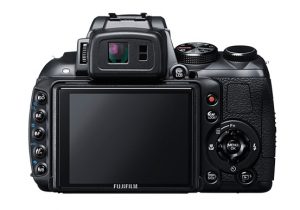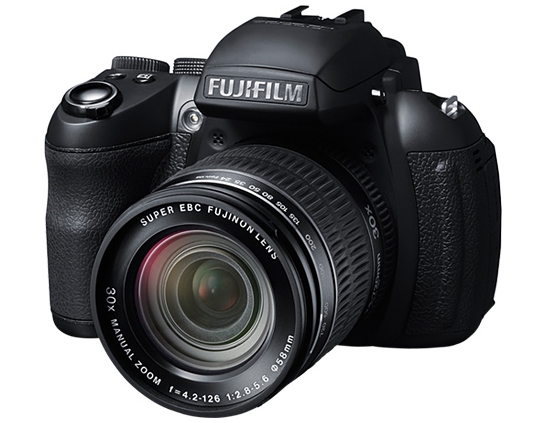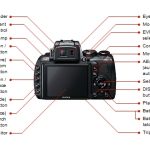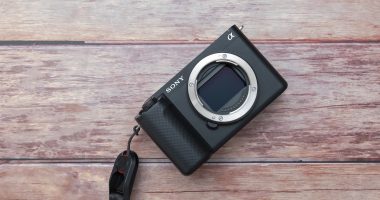You may remember a couple of weeks back I had the pleasure of testing out the FujiFilm FinePix F770EXR when it first came out. That was a very compact, 20x optical zoom camera which I actually liked very much. Great image quality and the super zoom really came in handy. Well, FujiFilm this time sent me their latest FinePix HS30EXR which is the complete opposite of the F770EXR when it comes to size. The HS30EXR is very comparable to the size of a standard DSLR, just a tiny bit smaller and even has a protruding lens on it like a DSLR. The only difference here is that it’s a fixed lens that can’t be swapped out. If for some reason the F770EXR wasn’t enough for you, the HS300EXR  should certainly be more than enough with many more features such as a larger optical zoom range (30x), ability to manually focus, an electronic viewfinder, tilt display, and a whole bunch of buttons to play with.
Exterior
The first thing you’ll notice right off is how very similar to a DSLR the HS30EXR is. In fact, if you didn’t know any better, you’d think that this was a DSLR and not a fixed lens, super zoom “compact” camera. Picking the camera up, it has a noticeable weight to it and is not light be any means. The size of the body and the lens contribute to that. If you’re looking for a small, light-weight super zoom camera, I suggest FujiFilm’s smaller F770EXR. The entire camera it matte black, but has no pare plastic exposed. Instead, most of it is coated in that rubbery soft touch coating and portions of the camera are textured to look like leather. This also adds to the DSLR-like feeling you get from the HS30EXR.
 Looking at the front of the camera, you’d be hard-pressed to tell that it isn’t a DSLR. There is a huge hand grip on the left and thankfully, it has a textured rubber skin on it for extra grip. It also has a nice groove in it for your fingers which makes it fairly comfortable to hold. To the very top right of the hand grip is where the AF assist light is. I’m not sure I really like the position of this here seeing as how your fingers can get in the way of the light and the position also seems like the popup flash and lens might also hinder its usage. Of course the main feature you’ll notice up front is the fairly large lens. It is about 3-inches long when retracted but can be as long as 5-inches when fully extended. I do like how FujiFilm has this lens marked though where you can easily see what the 35mm equivalent focal length would be at any given turn of the zoom ring. It starts at 24mm and goes all the way up to a whopping 720mm! That’s a pretty broad range coming from 1 lens, which is pretty amazing. One thing to note about the lens, I do find it kind of strange that the focusing ring for the lens is located on the rear near the body instead of up front where they usually are. Not sure why this is but it definitely takes getting used to. Above the lens, you’ll notice 2 little dotted dimples. These are where the stereo microphones are located.
Looking at the front of the camera, you’d be hard-pressed to tell that it isn’t a DSLR. There is a huge hand grip on the left and thankfully, it has a textured rubber skin on it for extra grip. It also has a nice groove in it for your fingers which makes it fairly comfortable to hold. To the very top right of the hand grip is where the AF assist light is. I’m not sure I really like the position of this here seeing as how your fingers can get in the way of the light and the position also seems like the popup flash and lens might also hinder its usage. Of course the main feature you’ll notice up front is the fairly large lens. It is about 3-inches long when retracted but can be as long as 5-inches when fully extended. I do like how FujiFilm has this lens marked though where you can easily see what the 35mm equivalent focal length would be at any given turn of the zoom ring. It starts at 24mm and goes all the way up to a whopping 720mm! That’s a pretty broad range coming from 1 lens, which is pretty amazing. One thing to note about the lens, I do find it kind of strange that the focusing ring for the lens is located on the rear near the body instead of up front where they usually are. Not sure why this is but it definitely takes getting used to. Above the lens, you’ll notice 2 little dotted dimples. These are where the stereo microphones are located.
Rotating the camera clockwise to the side, these is where the ports are located. The port cover is a rubber cover that is textured to match the surrounding plastic on the side. You don’t notice it at all and it blends in quite well. I like what FujiFilm did here with the ports and offered up a standard mini-USB port which means that a majority of you already have one of these cables handy. I like when companies use these because it means that I can use my 1 mini-USB cable for a variety of gadgets. I absolutely hate it when cameras come with a custom port that requires a new kind of cable that I am forced to carry around just for that camera. On this side of the camera, you’ll also notice a small speaker opening as well as the neck strap eyelet. Just above that is the flash release button that pops the flash up when you need to use it.
 Moving to the back of the camera, those coming from point-and-shoot cameras may be a bit overwhelmed by what they find. What you find out back are a whole bunch of buttons for various functions and settings. Not only are there the usually array of buttons on the right side of the display, you now also have 5 more buttons located on the left side of the display that are used to adjust a variety of shooting options and well as playback options. Most of these buttons on the left though will only be used mostly in the C, M, A, S, and P and Auto mode and will only be functional in the other modes based on what you are doing. Most of the buttons are pretty self explanatory and are labeled pretty well so you’ll be able to at least figure out what most of them do without reading the manual.
Moving to the back of the camera, those coming from point-and-shoot cameras may be a bit overwhelmed by what they find. What you find out back are a whole bunch of buttons for various functions and settings. Not only are there the usually array of buttons on the right side of the display, you now also have 5 more buttons located on the left side of the display that are used to adjust a variety of shooting options and well as playback options. Most of these buttons on the left though will only be used mostly in the C, M, A, S, and P and Auto mode and will only be functional in the other modes based on what you are doing. Most of the buttons are pretty self explanatory and are labeled pretty well so you’ll be able to at least figure out what most of them do without reading the manual.
The FujiFilm FinePix HS30EXR features a rather nice tilting screen that can tilt to face both up and down. The tilting mechanism feels pretty solid but doesn’t seem to be as nice as the ones I’ve seen from both the Sony NEX-5N and the Olympus PEN E-PL3. Just above the windscreen you’ll find an electronic viewfinder, much like what we saw with the Panasonic Lumix G3 that reviewed a couple months back. However, the viewfinder on the HS30EXR seems better because it has an eye sensor that automatically switches your view from the viewscreen to the viewfinder which I find rather handy so you don’t have to fumble with the button.
The last bit back here on the far right where you’ll find a really nice hump that allows you to grip this area better with your thumb and also helps with the positioning of your thumb in order to use the command dial.
Turning the camera once again clockwise, you’ll find the rather generously sized hand grip. This is thanks in part to the rather large battery included. There is something different here though that I haven’t seen yet with all the other cameras I’ve looked at. Unlike most that have the memory card slot located where the battery is, the HS30EXR has the memory card slot located on the side of the camera separate from the battery. I rather like this design because it is much easier to take the card in and out from the side, especially if you are using a tripod which can get tricky if located on the bottom.
 Now lets take a look at the top of the HS30EXR. Looking at it from above, you get a sense of how big and how DSLR-like the camera really is. Up top we get a hotshoe right above the popup flash which is generally where this is located. To the right of the flash, there are 2 dials – the mode dial and the command dial. The mode dial obviously is to choose which mode you want to shoot in while the command dial is used to quickly adjust settings like aperture, shutter speed, and ISO. Aboce these 2 dials, you’ll find the Exposure Compensation button and Continuous Shooting button. Again, more buttons means less having to fumble through the onscreen menus. Above those two buttons, you’ll find the shutter button with and on/off dial surrounding it.
Now lets take a look at the top of the HS30EXR. Looking at it from above, you get a sense of how big and how DSLR-like the camera really is. Up top we get a hotshoe right above the popup flash which is generally where this is located. To the right of the flash, there are 2 dials – the mode dial and the command dial. The mode dial obviously is to choose which mode you want to shoot in while the command dial is used to quickly adjust settings like aperture, shutter speed, and ISO. Aboce these 2 dials, you’ll find the Exposure Compensation button and Continuous Shooting button. Again, more buttons means less having to fumble through the onscreen menus. Above those two buttons, you’ll find the shutter button with and on/off dial surrounding it.
The bottom of the camera is pretty typical. The battery door is located at the bottom where the hand grip is. The tripod mount hole is also there except I do not really like where FujiFilm has it placed. It is not placed on the center axis of the lens and I think it is located too closely to the batter door. That means that if you have a tripod attached, you will not able to open the batter door and would need to remove it to get to the battery.
Final Thoughts
The FujiFilm FinePix HS30EXR is quite a camera. It’s a natural step up from more compact point-and-shoots for those who want something with more advanced features and more control over the settings. It’s also for those who don’t quite want to deal with a DSLR and the need to buy numerous different lenses for it. The range that the HS30EXR covers takes the place of about 2 or 3 lenses and at a far more reasonable price. With the price of most telephoto lenses these days, I could buy 2 or more of these cameras.
I really like the build quality on this camera and it seems to be really solid to hold and use. It feels very comfortable in my hands and the huge hand grip makes it easy to also shoot one handed if need be. There are a few weird quirks about it like the position of the manual focusing ring and the the position of the tripod mount, but these are things that are easy to live with and does not really affect the overall use of the camera. Overall, I really like the camera so far and hopefully, the photos and feature set of the camera win me over like the design of the camera has so far.
Shop Links
FujiFilm FinePix HS30EXR -Â Fujifilm FinePix HS30EXR Digital Camera







